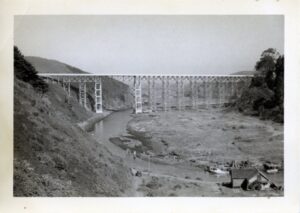Tom Wodetzki of the Albion Bridge Stewards recently gave the Kelley House Museum an interesting document. Its title is “Final Construction Report for the Construction of a Timber, Steel and Concrete Bridge Across the Albion River,” dated August 29, 1944.

Believe me, readers, this is mostly dry, statistical reading for 97 pages, ending with five pages of cool old photos, but it does have great tidbits of information in it.
The Stewards want to see the Albion Bridge survive. The State wants to tear it down and replace it. Love it or hate it, for 75 years it’s been part of our landscape and travel routes, and in the 1940s folks eagerly awaited its completion.
In this document you’ll find a description of the project, inspections, what was accomplished, reports of construction performance, statistics, expenditures, and a report on where the steel for construction came from in the middle of World War II.
There was no Highway 1 back then, the coast had secondary route 56. In four miles it joined secondary route 58 and went east to what was called State Route 1, or U.S. Highway 101. The main users of the coast road were lumber trucks, local trucks and passenger auto traffic, and seasonal tourists and sportsman automobile traffic.
The new bridge was needed because of the unsafe conditions of the 16.4-foot wide water level bridge built over the Albion River in 1929. There was a mile of narrow road with “up and down” grades and numerous short curves to get down the north bank and back up the south bank. Towns were listed as North Albion and South Albion. Sheep grazing was the main use of the land where the bridge would be built.
The bridge was designed to use a minimal amount of critical materials needed for the war effort. Upon completion it was to be 969’ long and 26’ wide with no sidewalks. There would be one steel truss 130’ long across the river channel and eleven 38’ timber trusses, with more details provided almost down to every nut and bolt used – it’s all listed.
First, work began on removing and salvaging an existing narrow-gauge railroad bridge across the south fork of the Feather River near Oroville. It had been built in 1929 by the Swayne Lumber Company and was on an abandoned rail line. Next, hand labor began clearing brush and eucalyptus on each side of the Albion River. A beautiful old church was in the right-of-way on the north bank and “other forces” accomplished its removal.
Tower footings began being built 13’ under water with cofferdams holding back water and work being done at low tide. Excavation found sunken logs and an “old timber boat” near the north footing tower. Bulldozers, cranes, and pick and shovel labor excavated footings and a “glory hole” (what’s a glory hole?) in shale rock. Pressure treated Douglas Fir from Wauna Lumber Company in Oregon was used, as redwood construction timbers in the right size were unavailable.
Stairways were built up and down the construction site to give workers access. Sand and gravel were shipped by train from Healdsburg to Fort Bragg, and then trucked to Albion. Water from a spring two and a half miles northeast of the bridge was piped to two 2,000-gallon storage tanks in North Albion. Pilings were cut five miles southeast of the bridge site and trucked in.
All structural steel was salvaged from other places (like that railroad bridge) and used to make the 130’-steel truss span. A State stockpile of iron in Rio Dell was also used. Everything was sent to Schroeder Iron Works in San Francisco for fabrication into what was needed. Work crews were described as adequate with the general superintendent earning $125 a week, laborers got $1.00 an hour and skilled workers got more. Carpenters earned $1.54 and welders $1.75 hourly, while gas for vehicles cost 17 cents a gallon. It was noted that everywhere there was a shortage of skilled laborers. All able-bodied young men were off fighting the war.
Planning began in August 1942 and even with a three-month shutdown from the War Board, that argued this was not a necessary war effort, the job was done by August 1944. If readers are curious to know more, they can come to the Kelley House Museum and read more and thumb through the Albion Bridge subject files. This new document is also available in digital PDF format.
The Research Office and Museum are open Fridays through Mondays, 11AM to 3PM. Contact us at 707/937-5791 or curator@kelleyhousemuseum.org.